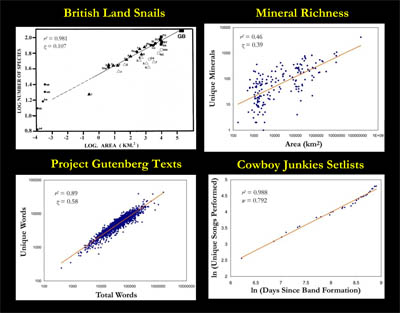
Ecological Theory and Modeling
Without the context provided by theory, ecological research may become bogged down in trivial detail. However, pure theory may easily become untethered from reality unless it is constantly informed by real-world observations. For this reason, I have chosen actively pursue theoretical issues while also maintaining an active research program spanning multiple frames of reference across multiple taxa groups. There are a number of biodiversity patterns which appear to be universal across multiple scientific disciplines. For instance, rarity-enriched Species Abundance Distributions, power-law Species Area/Time Relationships, and non-linear Distance Decay patterns appear ubiquitous across a wide array of complex systems, including not only ecology but also meteorology, geoscience, materials science, economics, sociology, and even the arts. Determining the common mechanisms underlying the distribution of trees in tropical forests, the longevity of drink tumblers in restaurants or of song performance frequencies in Cowboy Junkies setlists will help ecologists and others understand what patterns are caused by statistical mechanics rather than disciplinary mechanisms such as birth, death, immigration, or competition for limiting resources. All disciplines must begin this search for such fundamental mechanisms which are both more universal and less explicitly mechanistic than those typically sought. In this way we will be able to define the rigid rules for life’s sonnet, within which there is an infinity of detail. We have now lead two working group meetings relating to this topic, one at the Santa Fe Institute in the spring of 2009 and a second at the Center for Theoretic Studies at Charles University in Prague, Czech Republic, in May 2010 which have focused on uncovering these fundamental drivers. A particular foci for my theoretical interests is consideration of the role played by spatial or temporal distance. In particular, I am interested in applying Tobler’s First Law of Geography: “Everything is related to everything else, but near things are more related to each other” to biogeographic analysis and modeling. For instance, this premise can be used, via gravity models, to predict the spread of organisms. Such models offer an important counterpoint to diffusion models as they assume landscape heterogeneity and do not require organisms to migrate via a moving wavefront. Gravity models provide a much more accurate portrayal of Zebra Mussel movement through small lakes of the upper Midwest USA than are possible via diffusion models.
Relevant Publications
Nekola, J.C. & B.J. McGill. 2014. Scale dependency in the functional form of the distance decay relationship. Ecography 37:309-320.
McGill, B.J. & J.C. Nekola. 2010. Mechanisms in macroecology: AWOL or purloined letter? Towards a pragmatic view of mechanism. Oikos 119:591-603.
Nekola, J.C. 2010. Acidophilic terrestrial gastropod communities of North America. Journal of Molluscan Studies 76:144-156
Nekola, J.C., A.L. Šizling, A.G. Boyer & D. Storch. 2008. Artifactions in the log-transformation of species abundance distributions. Folia Geobotanica 43:259- 268.
Moses, M.E., C. Hou, W.H. Woodruff, G.B. West, J.C. Nekola, W. Zuo & J.H. Brown. 2008. A General Model of Ontogenetic Growth II: Estimating Model Parameters from Theory and Data. The American Naturalist 171: 632-645.
Nekola, J.C. & J.H. Brown. 2007. The wealth of species: ecological communities, complex systems, and the legacy of Frank Preston. Ecology Letters 10:188-196.
Nekola, J.C. & P.S. White. 2002. Conservation, the two pillars of ecological explanation, and the paradigm of distance. Natural Areas Journal 22:305-310.
Bossenbroek, J.M., C.E. Kraft & J.C. Nekola. 2001. Prediction of long-distance dispersal using gravity models: Zebra Mussel invasion of inland lakes. Ecological Applications 11:1178-1788.
Nekola, J.C. 1999. Paleorefugia and neorefugia: the influence of colonization history on community pattern and process. Ecology 80: 2459-2473.
Nekola, J.C. & P.S. White. 1999. Distance decay of similarity in biogeography and ecology. Journal of Biogeography 26:867-878.
Last Edit: April 30, 2017 |
|
|
|
